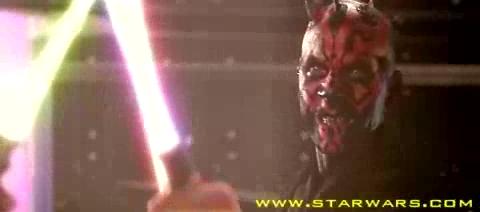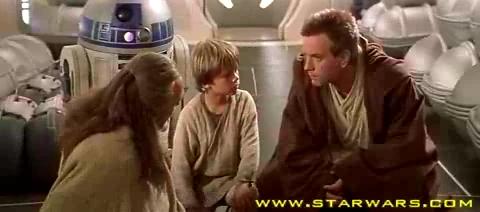It was 6 years ago that George Lucas began savaging the emotions of old-school Star Wars fans by unleashing Star Wars Episode I: The Phantom Menace. I have blocked out many of my negative memories of that film (which I only viewed once). Strangely, the fondest memories I have surrounding the film were of the downloadable trailers. Odd as it sounds, these QuickTime trailers were a large part of what inspired me to study multimedia technology.
In early 1999, the word was out that Apple had posted to the web these awe-inspiring trailers. The files showcased remarkably higher resolution than anything that was easily downloadable before. This screen capture of Master Yoda was taken from the first Phantom Menace trailer. For Linux users, the most notable feature of these new multimedia files was that they could not be played under Linux.

In you much fear Yoda senses, hhrrmmm?
The trailers were encoded in SVQ1. This was known as Sorenson Video 1 and it was a big selling point of QuickTime v4. Up until SVQ1 was available, most QT videos distributed via the internet were encoded with Cinepak. SVQ1 offered stunning video quality by comparison. These Star Wars trailers, encoded at 480×212 resolution, decoded in realtime on my 200 MHz PC at the time. I was puzzled that when The Matrix trailers hit the net after the Star Wars trailers, they had trouble decoding in realtime. I would later learn that the former used QDesign, a perceptual audio codec, for the soundtrack while the latter used good old IMA ADPCM.

I blocked out many of my Episode I-related memories, but I do remember that Darth Maul did not get nearly as much screen time as he deserved.
I actually get nostalgic thinking about those old trailers since they inspired me to study QuickTime structure and figure out ways to reverse engineer binary codecs. In the end, we reverse engineered SVQ1 right around the time that Episode II: Attack of the Clones was rolled out in theaters. This time, the trailers were encoded in Sorenson’s next codec, SVQ3. Fortunately, the open source multimedia community managed to reverse engineer that codec by about a year after the first open source SVQ1 implementation was released.
So now, Star Wars Episode III: Revenge of the Sith is upon us. A new version of Apple’s QuickTime has just been released (still only for Mac OS X as of this writing). Unfortunately, no new Star Wars trailers have been posted in hi-def/H.264 AVC encoding. If there was one reason I was looking forward to Episode III it was because I wanted to see new QuickTime technology.
Let’s not forget about another critical multimedia angle here: Lucas’ insistence that all theaters must go digital. You may recall that for many years, Lucas has prophesied that every theater should have a fully digital video and audio presentation experience in order to maximize movie-going enjoyment. Typically, this vision included distributing the movie via satellite feed. It is now 2005 and I still do not see any of this as commonplace.

Okay, here’s the play: Anakin, you go long, Obi-Wan will run defense, R2 will chirp incessantly as normal. Use the force and whatever you do, don’t pass the ball to Jar-Jar.
Ideally, a movie’s merit will continue to be judged as it has always been judged: By the quality of the content presented, not the resolution and decibel level of the presentation. To put it another way. no amount of crystal-clear digital imaging or multi-phonic audio will make Jar-Jar Binks any more palatable to the typical moviegoer.